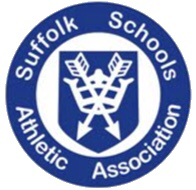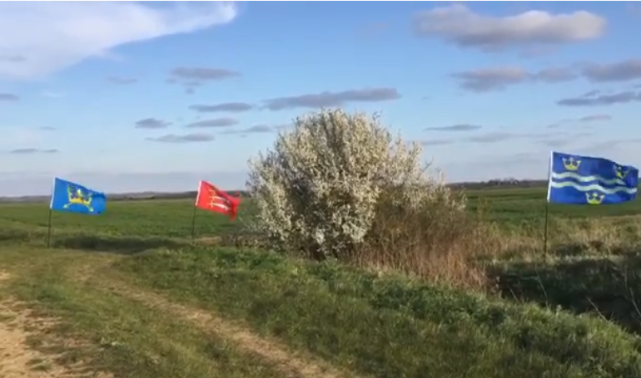
Suffolk’s flag was added to the registry on October 9th 2017. The design from the shield in any coat of arms may be depicted in flag form, as an “armorial banner” or “banner of arms”, whereby it is stretched to fill a rectangular shaped cloth and the Suffolk flag is a banner of the arms

attributed to Saint Edmund, bearing a golden crown “pierced” by two golden arrows, against a blue background. Described heraldically as “Azure two Arrows in saltire, points downwards, enfiled with an ancient Crown Or.”

The earliest attested deployment of this acknowledged county emblem, in banner form, is from July 1954 when the flag seen below

was raised

to welcome Princess Margaret to the Suffolk Regiment, following her appointment as its colonel in chief, in May 1953. Registration of this design was formally requested, sixty-three years later, by twenty-one county organisations, following its display by Suffolk County Council on the inaugural “Suffolk Day” June 21st 2017

Edmund, the last King of East Anglia, was reportedly murdered by the Danes in the year 870. When, at a meeting with the invaders, he refused to share his kingdom, he was scourged, bound to a tree,
shot with arrows

and then decapitated. Edmund’s arms accordingly reflect his kingship and the manner of his death. They appear in “Saints, Signs and Symbols” by W. Ellwood Post, 1964
Several sites lay claim to being the scene of Edmund’s gruesome demise but the oldest appears to be a field, near “Abbey Hill” just outside the village of Hoxne, in the north of the county, which lies just south of the county boundary formed by the River Waveney

A vast oak tree once located here was said to have been the tree to which Edmund was tied. It reportedly collapsed suddenly one night in 1843 and examination determined that it was over a thousand years old! Several iron points were discovered embedded in its trunk suggesting that the claim for the tree may have some credibility. Several years later, in 1849, a monument to the martyred king was erected at the spot where the oak stood

boldly decorated with the saintly monarch’s arms

and accordingly the county flag, the same arms in banner form, has been displayed at the monument

A beautiful depiction of the arms, in stained glass,

is found in a window at the church of Saint Peter and Saint Paul, located in the village and Hoxne’s village sign includes both Saint Edmund’s arms and a representation of the tree to which he was tied.

Saint Edmund’s arms are also found etched on a boulder

beside St. Stephen’s Chapel in Bures St. Mary, where, it is believed, the 14-year-old Edmund was crowned King of the East Angles on Christmas Day 855.
Edmund’s burial site and shrine, is located at Bury Saint Edmunds,

eponymously named for the martyred king, where a modern statue of him by Elisabeth Frink,

is located close to the cathedral and abbey ruins, seen above. The martyred king is also found in the cathedral, presenting his arms

which are further found on the exterior wall, carved in to the stone

and are a decorative feature of Church Walk, in the town,

as a modern metallic depiction. There is a stone carving of the arms at All Saints Church, Honington

a beautiful carved wood depiction on the door of Saint Edmund’s church, Fritton

and they hang as a banner, at St Edmund’s church, Parksville, British Columbia, Canada

The martyred king is portrayed beneath his arms, below, in stained glass

and on the tower of Southwold’s parish church, in the county, a crown from Saint Edmund’s arms appears over each letter of a votive inscription in his name

The martyred King of East Anglia, is also found at Saint Edmund’s Church, Downham, in neighbouring Norfolk
 With his firm association with the county, an armorial banner of Saint Edmund’s Arms is the indisputable flag of Suffolk, several of whose towns include the crown and arrows theme in their own emblems. The great abbey which grew up around Saint Edmund’s shrine used arms
With his firm association with the county, an armorial banner of Saint Edmund’s Arms is the indisputable flag of Suffolk, several of whose towns include the crown and arrows theme in their own emblems. The great abbey which grew up around Saint Edmund’s shrine used arms

depicting three of the crown and arrows devices from the attributed arms of King Edmund. It is probable that the trio of crowns was based on the three crowns attributed to the first East Anglian dynasty, the Wuffingas

A small town subsequently developed around the abbey, which Henry VIII ordered to be dissolved in 1535; it was plundered of all its valuables and people of the surrounding town made use of its stone for local buildings. By 1539 the arms of the abbey were no longer in use. In 1663 the town of Bury Saint Edmunds became incorporated, granting it the right to bear arms of its own and in recognition of Saint Edmund and the former abbey, it received a blue shield bearing the same three gold crowns although with distinctive silver arrows

The town’s arms appear in this illustrative plate

and they can be found adorning the town’s guildhall
The trio of crowns and arrows duly featured on Edmund Bowen’s eighteenth century map of the county.
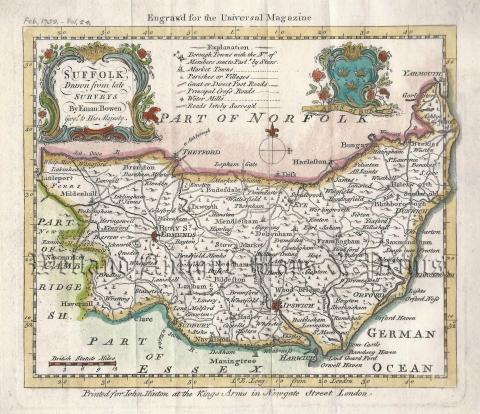
They appeared again, in the following century, on Thomas Moule’s Suffolk map

in two distinct, variant forms; once as part of a decorative arrangement of shields at the left of the map,

where each of the three gold crowns is “pierced” by two arrows, which are inverted so that their tips point upwards and also at the bottom right,

where, on a shield held in the hands of a seated figure, all three crowns are pierced with the same two, similarly configured, upwards pointing arrows. Whilst the fixed form of crown and arrows

as seen on this example from the font of Worlingworth Church, which appears on the county flag has existed for several centuries, such variations of the basic theme, as feature on this county map, have also been fairly common. This example
arranges three crowns around a single downward pointing arrow and was found on the porch of Fressingfield Church. Another version similarly shows three crowns with a downwards arrow
which ‘pierces’ the lower crown. Examples of this arrangement were found at Laxfield Church porch and on the font at Halesworth Church. On a third pattern
a single crown appears between two diagonally crossed arrows, heraldically described as “saltirewise”. This version was found on the font in Downham Church. A further pattern
depicts a single arrow piercing a single crown.
In 1974, the Borough of Bury St Edmunds was combined with adjacent areas into the Borough of St Edmundsbury and a new coat of arms for this borough was created

which features two of the arrow pierced crowns of Saint Edmund. Its council also uses a single Saint Edmund crown and two arrows device as a logo A new town council was re-established for Bury Saint Edmunds itself in 2004 and in 2006 this was re-granted the arms of the original Bury St Edmunds Town Council
A new town council was re-established for Bury Saint Edmunds itself in 2004 and in 2006 this was re-granted the arms of the original Bury St Edmunds Town Council

The crown and arrows emblem has been adapted for use as the club badge by the town’s football team Bury Town FC,

the badge of the Bury Saint Edmunds squadron of the Air Training Corps

and is the badge of the “1st Bury St Edmunds Mayor’s Own Scout Group”
in a form and colour scheme that unequivocally recalls the county flag.
Further afield in the county, the crown and arrows are used by Framlingham College;

the town of Beccles;
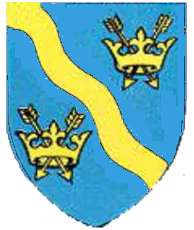
and the coastal town of Southwold
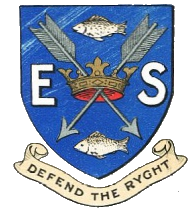
, also seen in the town’s seal which appears on an entrance sign

and here

on this commemorative coin. The combination is also used as a logo by Southwold Sailing Club

and deployed as a pennant

in the actual St Edmund colours of gold on blue

and features as the logo of the local band

The device further appeared on the arms of the now defunct, West Suffolk Council,

whilst two feature on the arms of Suffolk County Council.

The solid Suffolk heritage of the Saint Edmund’s arms has also been recognised by the Suffolk Institute of Archaeology and History whose own emblem includes the arms of Saint Edmund at its centre
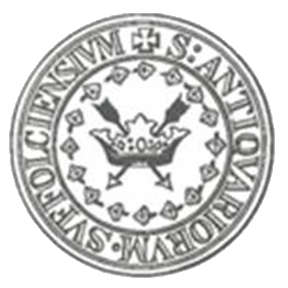
Such recognition attests to the emblem’s status as the natural symbol of the county. This recognition is further found in its use by the county’s scout association, seen below in differing realisations, including the actual form of the Saint Edmund’s arms, with a gold crown and arrows against a blue background.

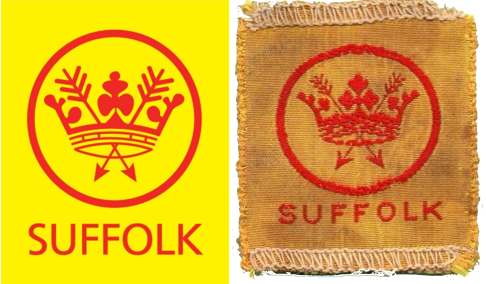
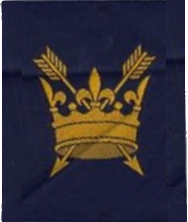
Other examples of its use around the county include its appearance as the logo of famous Suffolk brewery Green King

the badge of the county’s carpet bowls association

its inclusion in the badge of a local football club located in Great Barton

and adaptation as a badge, with the trio of crowns, by a local branch of the Women’s Institute.
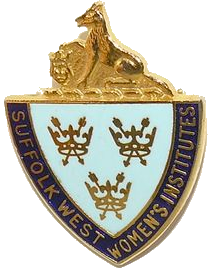
A modern form of Saint Edmund’s Arms is used as a badge by the county’s school’s athletic association
and the body also displays a banner with the device when in competition
; another clear precedent of the Suffolk emblem deployed in flag form, representing the county of Suffolk, following its original 1954 usage .
Another notable use of the Saint Edmund’s arms to represent the county was their appearance on the front cover of his 1930 guide to Norfolk and Suffolk
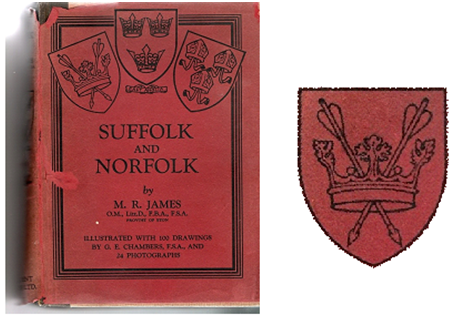
by celebrated mediaeval scholar and acclaimed writer of ghost stories, M.R. James. The county emblem is also present on this commemorative 1959 tea towel from the town

which additionally features the regional flag of East Anglia in the lower right corner.
The acknowledged county emblem, an armorial banner of Saint Edmund”s arms, was commissioned as a flag
in 2014, by a Suffolk resident, from the manufacturer Mr Flag, whose chief executive, Charles Ashburner, crafted the crown and arrows device that appeared on it.
In 2017, the county held its inaugural ‘Suffolk Day‘, on June 21st, an occasion marked with use of a special logo, which featured the county’s traditional crown and arrows emblem
 Saint Edmundsbury Cathedral provided another marked use of the recognised county emblem of gold crown and arrows, against its traditional blue background, to promote the county day
Saint Edmundsbury Cathedral provided another marked use of the recognised county emblem of gold crown and arrows, against its traditional blue background, to promote the county day

a lamppost adorned with his arms stands next to Bury Saint Edmunds Cathedral
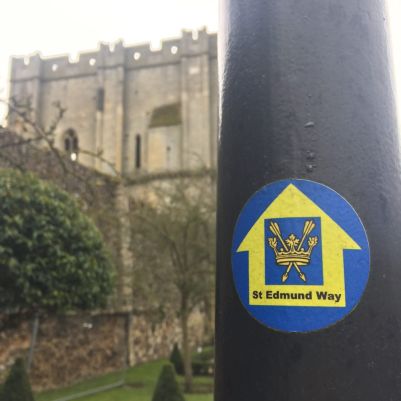
On the day itself, June 21st, Suffolk County Council flew the armorial banner of Saint Edmund, over its headquarters, Endeavour House, in Ipswich, announcing the fact on its Twitter account
declaring that it was flying “our…St Edmund flag”, “high for Suffolk”, in an unequivocal expression of its approval for use of the design as the county flag.
Further usage of the St Edmund banner of arms was made by the Ipswich Building Society where a local history talk on the day was decorated with the design
The Saint Edmund banner has also been incorporated by fans of Suffolk amateur club, Stowmarket Town, into their own flag

In light of this widespread usage of the Saint Edmund arms around the county and following its deployment as a flag by the council and others on the county day, an effort was initiated to see the design formally registered as the county flag of Suffolk. In addition to the county council’s demonstrated approval, this move was supported by the following twenty-one county organisations;
Bacton & Cotton Local History Society
Suffolk Schools Athletic Association
Stoke by Nayland Local History Society
Worlingworth Local History Group
Walberswick Local History Group
Wickhambrook Local History Society
Stowupland Local History Group
The Alde Valley Suffolk Family History Group
Suffolk Schools and Youth Hockey Association
Clare Historical and Archaeological Society
Little Waldingfield History Society
Glemsford Local History Society
Felixstowe History and Museum Society
Suffolk Agricultural Association
Nayland with Wissington Conservation Society
with one of their number, Suffolk Schools and Youth Hockey Association, submitting a formal request for registration of the proposed design,

which collated all the background information and detailed support, to the Flag Institute, in July 2017. The organisation duly acknowledged the flag, reworking the design upon registration

and shortly afterwards, it was raised for Saint Edmund’s Day, November 20th 2017.

The county flag is seen here

flying domestically and adorns the wall of Ickworth House below

It is seen here

caught in a gust at Felixstowe Museum.
Below, the flag

decorates the wall of Southfolk Brewery, “Getting ready for the Suffolk Day brew”.
The Suffolk flag was much in evidence on June 21st 2018, “Suffolk Day”; it was raised by the Mayor of Felixstowe (video available here)


flew in the village of Tattingstone;

and was hoisted at its Sudbury works, by Anglia Water;

The Women’s Institute in Ipswich also celebrated the county day, improvising, for lack of a flagpole!

One county resident made her feelings clear, with a poster expressing county pride;

and the same design was displayed on a commemorative tea towel

The following year the county flag was raised at the Ipswich Waterfront,

, lined the streets of Brandon
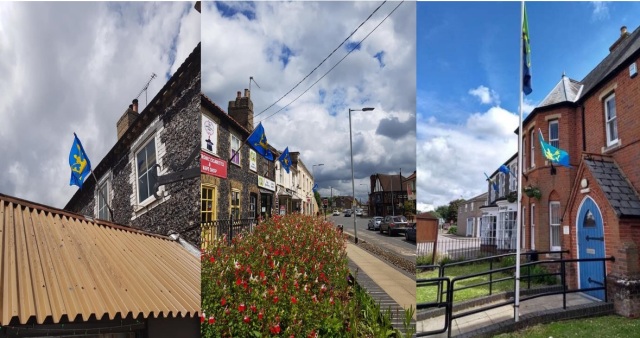
and decorated the sands of Lowestoft.

A splendid evocation of the county flag was created at the Orwell Hotel, Felixstowe, by pastry chef Nick Miles


and the town’s Mayor, Nick Barber and Deputy Mayor, Mark Jepson, raised the Suffolk flag at Felixstowe museum

The flag bedecked a county cottage in the form of bunting


and flew proudly over Elmswell Church

The Suffolk flag is seen below at left,

looking west at the bridge over the River Waveney, just north of Hoxne, which forms the county boundary, marked with the respective county flags of Suffolk and Norfolk and the flag of East Anglia in the centre.
Here

the Norfolk and Suffolk flags are seen marking the bridge, east of Gasthorpe and Knettishall, over the Little Ouse, which forms their county boundary at this spot. In the below two photos


the Suffolk and Cambridgeshire flags mark a footbridge at Isleham Marina, spanning the river Larkh, which forms the mutual county boundary and here


the Suffolk and Essex flags are seen on a footbridge spanning the River Stour, forming the counties’ mutual boundary. And below
the flags of the three counties of Suffolk, Essex and Cambridgeshire are seen together at the tripoint where they converge.
On Saint Edmund’s Day, November 21st, 2019, the flag was raised by B Company of the Suffolk cadets

and residents of Ringsfield in Suffolk raised their county flag over the village’s All Saints church

The flag has also been taken on tour to Panama by a county group celebrating World Youth Day

and is flown by the fire fighters of Bury Saint Edmunds

In 2020, the crown and arrows of the flag appeared on local produce

sold in Suffolk branches of Morrison’s and Tesco

supermarkets.
Although the crown and arrows of Saint Edmund had been raised in 1954, the notion of reviving their use on a flag for the county, was suggested by local resident Bill Bulstrode,

who proposed a design with the Saint Edmund arms as a shield on the cross of Saint George, laudably highlighting the county’s lack of a recognised flag of its own.

This design, however, is almost identical to the flag of the region of East Anglia as a whole



(of which Suffolk is, of course, a part!) which is over a century old and was amongst the first flags included on the Flag Institute’s registry; indeed the design is actually based on the flag of East Anglia. This proposed flag was therefore not eligible for registration, both for lack of distinction and, because the design was a registered trademark, as indicated by the circled letter “R” below

, the design was automatically ineligible as all registered flags must be in the public domain, although it appears that the copyright was later removed.
Additionally, the arms of Saint Edmund were eminently suitable for registration as the county flag, further detail was unnecessary. In this context the cross of Saint George conveys nothing specific about the county of Suffolk; the Saint Edmund arms themselves are evidently representative of the county, inclusion of the Saint George’s cross is superfluous. And, whilst variations of red crosses are legion, the Saint Edmund arms
are distinctive, eye-catching and present a flag uniquely Suffolk in character.
Two other designs are associated with the county; an armorial banner

of the Suffolk County Council arms

which it seems is actually not used and a flag which places the shield from its coat of arms, on a yellow cloth

, in contravention of standard heraldic practice (page 10). Neither of these represents the county
but just the council which runs it, as an administrative body.
The county flag flew over Parliament Square, Westminster

along with other county flags

on July 23rd 2019, Historic County Flags Day #countyflagsday


The Suffolk flag is promoted by county native and enthusiast for all things Suffolk – culture, tradition, local recipes and history – Ben Archer.

Useful Links











